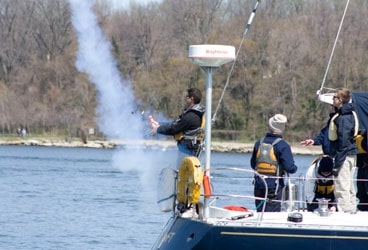
pyro testing 368
A boat on the ocean is a small, hard-to-see target in good conditions, and even with all the technological advances in EPIRBs and communications technology that interface GPS information with the VHF radio, nothing can help rescuers get a visual fix on a boat in distress better than a flare or other visual signaling device. The U.S. Coast Guard requires you to carry the proper visual distress signals on board, and it’s important to know how to use the different types in an emergency.
Aerial signals: Aerial signals are used to alert all the boats in the area that you’re in trouble. They’re fired from a variety of self-contained launchers or specifically designed pistols, and can reach an altitude of 450 to 1,000 feet. The combination of bright light and high altitude makes these flares highly visible from a long way off, but most have a relatively short burn time. The U.S. Coast Guard recommends firing two aerial signals-one immediately after the first has gone out-so that in an emergency, rescuers can confirm the sighting and/or the direction of the signal.
Handheld signals: Once you’ve alerted boats in your area that you’re in distress and have given rescuers a general idea of your location with aerial signals (and, often, radio or EPIRB contact as well), a handheld signal emits a bright light that will help your rescuers to zero in on your position. In an emergency, your rescuers have seen your aerial signals, confirmed your position on the radio, and use the light from a handheld to steer directly to you.
Smoke signals: Smoke signals are somewhat similar to handhelds in that they are designed to help pinpoint the location of a vessel in distress; they do so by emitting a thick, colored smoke rather than light. They’re obviously of no use in the dark, but in daylight, a big plume of colored smoke is often more visible than the bright but relatively small light emitted by a handheld flare. And most smoke flares will float and work on the water.
All pyrotechnic signaling devices must be stored in a cool, dry place, and most are available with a tough, plastic, waterproof storage case. Make sure you keep the signaling kit in an easily accessible location on your boat. And remember: It’s illegal to fire a distress signal in a non-distress situation.
Non-pyrotechnic signaling devices: Not all signaling devices need to be “fired” to be effective. Battery powered, flashlight-like rescue lasers usually can be seen from over 20 miles away and have up to 40 hours of battery life. There are also marine signaling mirrors that have a tiny hole in the middle so you can aim the reflected sunlight at a passing ship or airplane. And there are also specially designed non-pyrotechnic signaling kits that include an orange distress flag and a dye canister that can be used to color the water around you or your boat.
As it is with all safety gear, the best-case scenario is one in which your boat is equipped with all the proper signaling devices and you never need to use them. On the one hand, you’ll have the small added expense of having to replace expired flares that you’ve never used, but you can hold on to expired flares to use as a backup; many may still work even after they’re out of date. On the other hand, isn’t the peace of mind that comes from knowing that you’re properly prepared to deal with the worst-case scenario totally worth it?
Bill Springer, CW’s senior editor, hasn’t had to fire a distress signal in an emergency, yet.
Signal Selection Guide
Equipping your boat according to the International Sailing Federation’s distress-signal requirements is the best way to make sure that you’ll be able to be seen when you really need to be seen. The ISAF minimum requirements, which exceed the U.S. Coast Guard’s minimum guidelines and are also required to participate in US Sailing events, are broken down into several categories: In Category 4 are inland boats that sail and race in warm, protected waters only during daylight hours. Categories 2 and 3 include coastal boats that sail and race in open water relatively close to shore. Categories 0 and 1 encompass offshore boats that sail and race offshore for extended periods.
Category 4
4 SOLAS red handheld flares
2 SOLAS orange smoke signals
Categories 2 and 3
4 SOLAS red parachute flares
4 SOLAS red handheld flares
2 SOLAS orange smoke signals
Categories 0 and 1
6 SOLAS red parachute flares
4 SOLAS red handheld flares
2 SOLAS orange smoke signals
U.S. Coast Guard Requirements
The U.S. Coast Guard requires that nearly all recreational boats over 16 feet be equipped with a minimum of three day-use and three night-use or three day/night combination pyrotechnic devices that are Coast Guard-approved. The required number of flares must also be replaced every 42 months and should be stored in a watertight container.
Are “SOLAS-Approved” Flares Safer?
The International Convention for the Safety of Life at Sea, or SOLAS, is a collection of safety requirements for all commercial shipping. According to Ron Trossbach, a moderator of US Sailing’s Safety-At-Sea Seminars: “SOLAS flares are safer, brighter, and longer lasting than non-SOLAS or USCG approved, ‘road’ style flares, and are much more likely to draw attention both day and night. SOLAS handheld flares burn without the molten metal slag which falls from other flares and SOLAS rocket flares don’t require a special launcher or flare pistol. We intentionally fire Non-SOLAS then SOLAS flares at our Safety-At-Sea Seminars so that our audiences can compare and see for themselves the vivid differences, which are self evident. This evidence justifies the additional cost of SOLAS flares.”
More Flares Info
ISAF: +44 (0) 2380-635111, www.sailing.org/specialregulations.php
Landfall Navigation: (800) 941-2219, www.landfallnavigation.com
Orion Signals: (800) 851-5260, www.orionsignals.com/marine
PainsWessex: +44 (0) 1489 884130, www.pwss.com
US Sailing: 800-877-2451, www.ussailing.org








